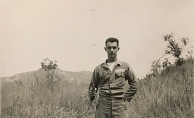At an age when most teenagers were asking their parents’ permission to stay out past their curfew, Henry “Hank” Liljequist was begging his parents for permission to risk his life to defend the country. Liljequist was just 17 in June 1943 when he convinced his father to sign the papers allowing him to join the U.S. Navy in the midst of World War II.
Liljequist went on to a life of service and exploration. Before he passed away in August at age 90, we had the pleasure of talking with Liljequist, a Plymouth resident, about his adventures.
After enlisting in the Navy, Liljequist hoped to serve as a pilot; he had been building model airplanes since grade school and took flying lessons while in high school. “I was born with a love of flight,” he said, but he failed the military eye test required of pilots and opted instead for a spot on the ground crew.
For the next two years, he was stationed in Hawaii, where he put his passion for planes to work as an aviation mechanic, repairing damaged fighter planes such as F4U Corsairs as part of the Carrier Aircraft Service Unit, working to get the Navy’s air forces back to the front lines as fast as possible.
Discharged in 1945 at war’s end, Liljequist briefly sold model airplanes in Minnesota as the owner of a hobby shop before enrolling in Embry-Riddle Aeronautical University in Florida to study aviation mechanics. While there, Liljequist saw a small private plane crash near campus. The pilot emerged unharmed, and Liljequist offered to buy the damaged Aeronca Model K Scout from him. “I bought it for a song,” said Liljequist. “Then I rebuilt it and got it airworthy.”
He used that plane to fly home to Minneapolis, and he had plenty of adventures along the way, from flying in severe storms to landing in a pig pen on a visit to a Navy buddy in Kentucky. “They still tell stories about the dumb Yank who did that,” Liljequist remembered with a laugh.
Once home, he went to work for Northwest Airlines (now Delta) as a flight engineer, which is how he met his future wife, Byrnel, a flight attendant. They were married in 1952 and bought a plot of land on Medicine Lake in Plymouth a year later.
The newlyweds built their dream home from scratch, literally. “We looked it up in books and did it all ourselves: framing, plumbing, electrical. That year, I bought my wife a cement mixer for her birthday.”
They raised three sons there, and Liljequist said those were the “best days of my life.” He was always involved in the community and was a founding member of the neighborhood group Association of Medicine Lake Area Citizens.
When we spoke with Liljequist last summer, he was as active as ever. Since moving to Saint Therese of New Hope in 2015, he had participated in nearly every activity the senior residence offers, from making ceramics to writing poetry. One of his poems celebrated the close bond he shared with the facility’s reception supervisor Linda Mayo.
“He would just come down to the front desk and visit me,” says Mayo. “He was like my dad.”
Mayo encouraged Liljequist to speak to students from nearby Armstrong and Cooper high schools, who volunteer at the nursing home as part of their job skills training, about his experiences, and he often shared with them the photos and flight logs he kept since the 1940s.
Liljequist also offered advice to those interested in joining the military after high school. Some of the student volunteers become quite attached to Liljequist, and “they cry when they graduate,” says Mayo.
Liljequist smiled when we asked him to share his secret for living a long and happy life. The key, he said, is to always have something to do and learn, whether it’s zipping across the country in an airplane or sharing a story with a new friend.









